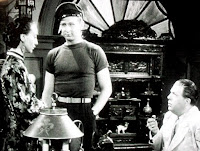 Letty (Charlotte Greenwood) is a wise-cracking dynamo who works at a Florida resort hotel as a beautician. Her husband Tommy is tired of his wife's constant ebullience and the fact that she's never at home to clean and cook. Their next door neighbors, Grace and Harry, have the opposite problem; Grace is a household homebody and he wants to live it up. One night, the couples decide to swap mates for a week, with the wives hoping it will make their hubbies appreciate them more. Meanwhile, Harry's rich uncle Claude (Claude Gillingwater) arrives for a visit with his two granddaughters who aspire to flapperdom; they first stop at the hotel where Greenwood's antics irritate Claude so much that he leaves and heads straight for Harry's. Complications ensue.
Letty (Charlotte Greenwood) is a wise-cracking dynamo who works at a Florida resort hotel as a beautician. Her husband Tommy is tired of his wife's constant ebullience and the fact that she's never at home to clean and cook. Their next door neighbors, Grace and Harry, have the opposite problem; Grace is a household homebody and he wants to live it up. One night, the couples decide to swap mates for a week, with the wives hoping it will make their hubbies appreciate them more. Meanwhile, Harry's rich uncle Claude (Claude Gillingwater) arrives for a visit with his two granddaughters who aspire to flapperdom; they first stop at the hotel where Greenwood's antics irritate Claude so much that he leaves and heads straight for Harry's. Complications ensue. The above is not a chronological summary; the movie actually begins with Claude and his daughters tangling with Letty at the hotel then moves to the stories of the neighbors. Despite Claude's importance at the beginning of the film, he vanishes from the action for a quite a while and the focus is really on the mate-swapping. Although this is an early talkie, it doesn't really feel like one; it rarely feels stagy or awkwardly paced. Your tolerance for this, however, will depend on how you feel about the lanky, raucous Greenwood, who gets to do a couple of her trademark leg lifts—with a nice visual payoff at one point when her husband tries to imitate her and lift his leg over their gate. Patsy Ruth Miller (as Grace) and Gillingwater turn in so-so performances, but Grant Withers (pictured above with Greenwood) is a little better as the restless Harry. There are a handful of awkwardly placed songs, but it's not really a full-fledged musical. The wife-swapping is the most interesting element here, though a brief reference implies that they will not be swapping in the bedroom. A unique relic of the early sound era. [TCM]

















